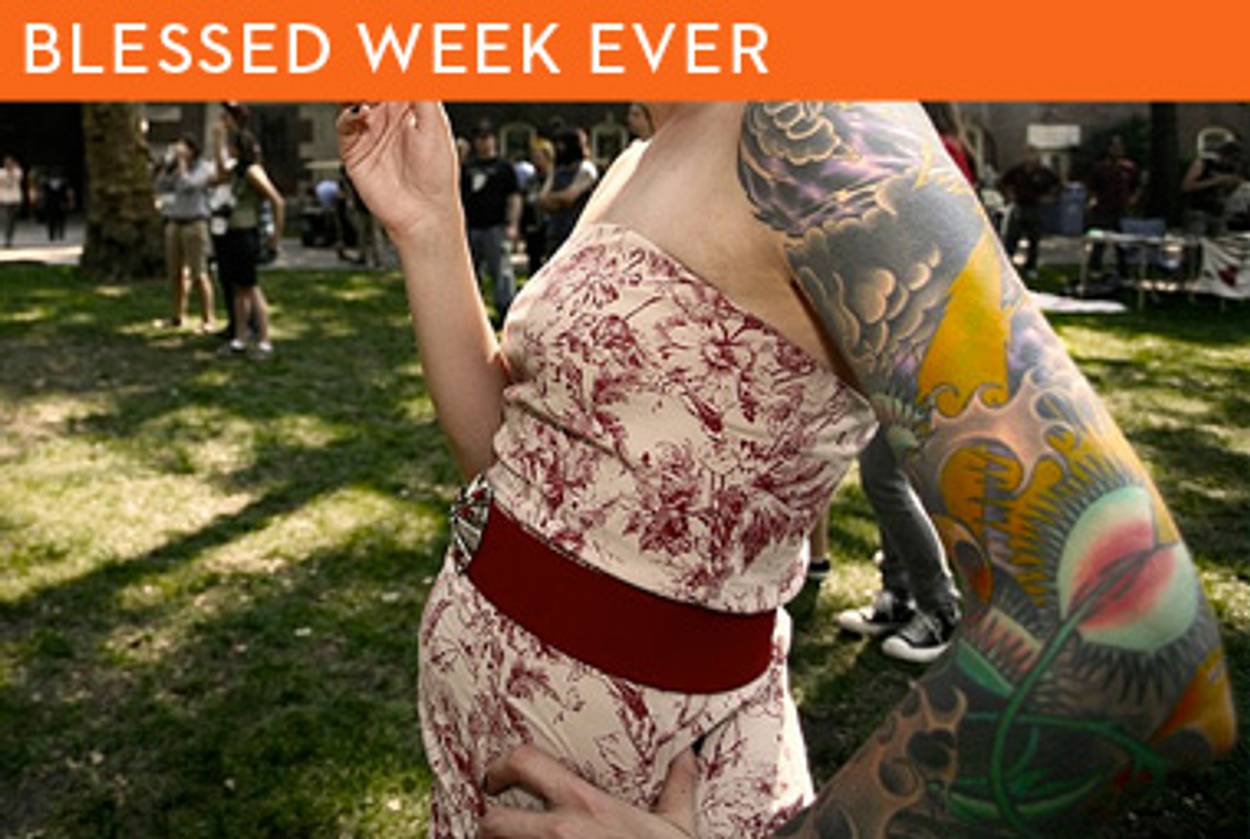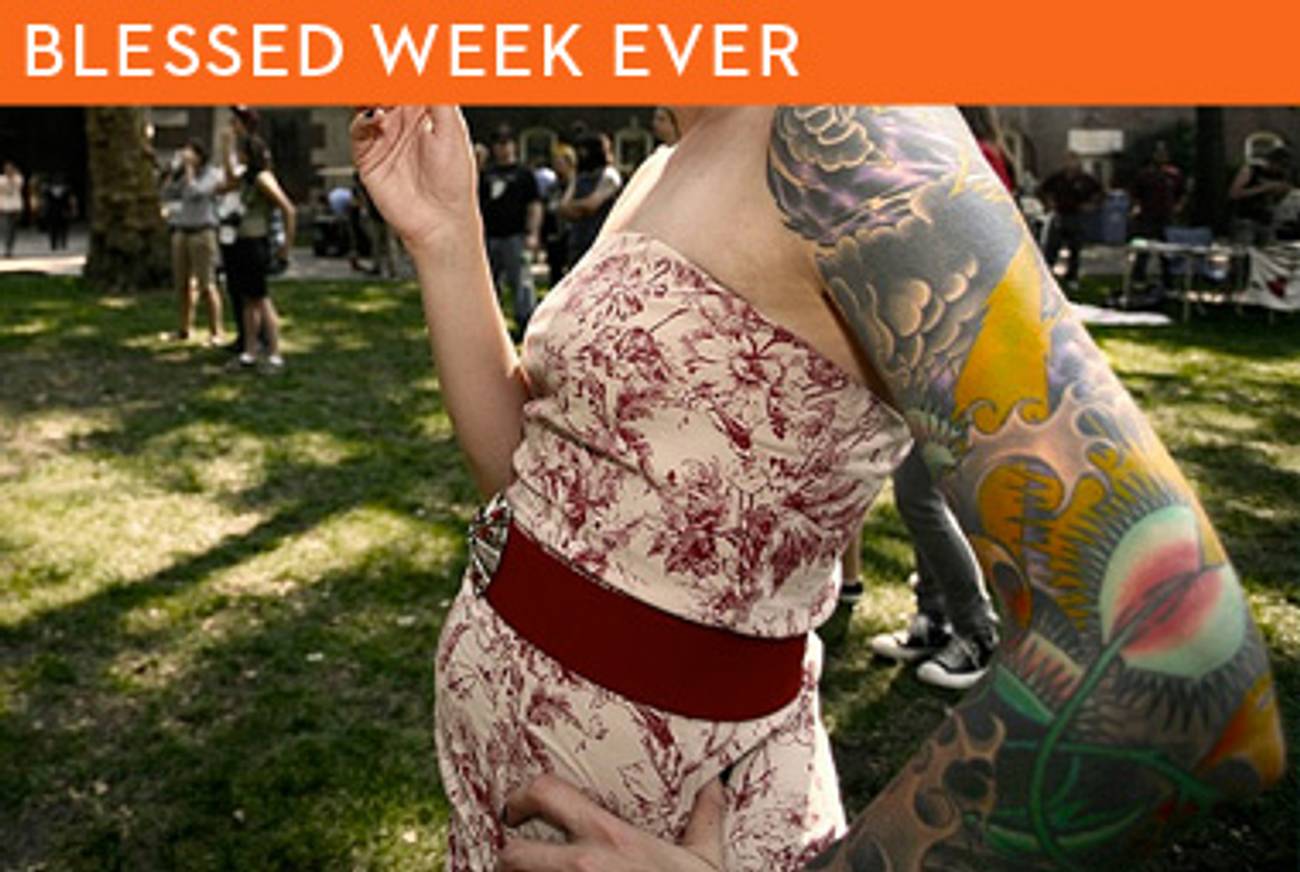Branded
I’d always wanted a tattoo, but believed, following this week’s parasha, that it was categorically prohibited. Before making the commitment, I had to wrestle with the text.




In this week’s Torah portion, Kedoshim, sandwiched between an injunction forbidding a man from shaving the edges of his beard and another that discourages fathers and brothers from turning their daughters and sisters into harlots, is the verse that has made Jewish parents everywhere rejoice for generations: the prohibition against getting tattoos. And it was with full knowledge of this commandment that, over Hanukkah, I went to a Brooklyn parlor with a friend and got my first tattoo.
As I sat in the chair with my leg elevated on a stool, the artist went to work with his motorized needle. My friend hovered nearby, squeezing my hand in support as waves of nausea and sweat rolled over me. The artist, a young man in his 20s whose epidermal surface area was almost entirely tatted up, asked if I needed a break. “No,” I moaned. “Just finish it.”
I wanted it to be over with as quickly as possible, and not just so my blood pressure would return to normal. After 10 years of wrestling with the decision to get a tattoo, I didn’t want to waffle at the last possible moment. I just wanted it done.
I chose a bumblebee, which is the literal translation of my Hebrew name. It was also a symbol for female leadership in the ancient Near East.
To those without a working knowledge of Hebrew, my tattoo seems devoid of an explicitly Jewish meaning. But as Rabbi Rochelle Kamins, the assistant director of youth programs at Kehillat Israel Reconstructionist Congregation in Pacific Palisades, Calif., noted in a study of Jews with tattoos, mine falls under the heading of “tattoos with symbolic Jewish meaning that don’t at first glance look ‘Jewish’ to an outsider.”
My desire for physical self-modification first surfaced back when I was a student in yeshiva high school, but was quickly quashed by studying the following verse in Leviticus: “You shall not make gashes in your flesh for the dead, nor incise any marks on yourselves: I am the Lord.” My teacher merely explained that this sentence was the root of the prohibition against tattooing. He told the class that scratching and marking the body were things that idolaters did to mourn the dead and worship pagan deities. None of us peppered him with the obvious follow-up questions: What about tattoos that aren’t connected to mourning rituals? What about a tattoo of a flower or something similarly innocuous? Were these also off limits?
“The verses in Kedoshim were understood rabbinically not to mean a tattoo that says ‘Mom,’ ” Rabbi Joshua Gutoff, a Conservative rabbi and former director of the University of Minnesota Hillel, told me recently. Had I known this as a high-schooler, I still doubt I would’ve run to get marked up. I was still under the impression that getting a tattoo would preclude me from being buried in a Jewish cemetery. So, I settled for altering my appearance in less permanent (though by no means less fun) ways. Like the leaves, my hair hue changed with the seasons. I pierced my ears multiple times. I dressed wildly. And for a time, that was enough.
For those who don’t have the need to show off, my urge might be difficult to comprehend, and Jewish tradition certainly does not help to bridge the understanding gap. As Jews, it sometimes feels like we only value our bodies from the neck up. “Traditional elite Judaism is a verbal culture,” Gutoff explained. As a youngster, I encountered this bias when I tried to enroll in gymnastics lessons. After being introduced to the sport at a birthday party, I began to pester my mother, a history teacher quick to call herself terribly uncoordinated, to take me for classes. At first, she rebuffed me, and I had to resort to traditional Jewish means to train: checking out all the gymnastics-related books from the library. After a year spent teaching myself skills from diagrams in books and crashing into our living room furniture, my mother finally found a gym for me to practice in. Though my mother was eventually supportive of my participation in the sport and my subsequent involvement in break-dancing, she never understood why I had to do it, and, as a child, I could scarcely articulate my reasons.
Not that I’ve done much better as an adult. Sure, like any overeducated Jew, I can intellectualize my compulsion with the best of them. I even wrote an entire master’s thesis about the relationship between Judaism and gymnastics. But no matter how hard I try, I feel like I’m always just missing the mark.
So it also was with tattoos. I readily acknowledge that it is highly irrational to brand your body permanently with an image you could just as easily (and less painfully) hang on your wall, yet I felt that was an inadequate substitute. The image, I felt, simply had to be embodied.
In 2007, the New York Times published a piece about tattooed Jews and burial rites, calling the whole claim that the inked-up were shunned from Jewish cemeteries a bubbemeiseh. I told my hair stylist, who at the time was touching up my brown roots with fuchsia paste. She has a sleeve full of ink that I’ve often admired, a painting of the beautiful night sky, reminiscent of Van Gogh’s Starry Night. “You should definitely get one,” she said.
And still, I waited. Knowing that I could be properly interred even with a tattoo was important but by no means the only barrier to my getting one. I’ve crossed many halakhic lines in my move away from Orthodox Judaism, but there seemed to be something so final about marking one’s body permanently even if it ranks below violations of the Sabbath and the laws of kashrut (two areas where I’ve transgressed). I wasn’t sure if I was ready to make that sort of statement.
There were also other reasons not to get inked. Though it is not difficult to redefine the verses in Kedoshim to permit the type of tattooing that is popular today, or to point to sentences in Isaiah that seem to allow or even encourage marking one’s body with the name of God, pointing to biblical verses only gets you so far. It is impossible to turn the legal clock back to biblical times and simply wrestle with the text; in the millennia since, rabbis have added their interpretations, and in a rare moment of consensus, every denomination—from Reform to Orthodox—has ruled against permanent body art regardless of intention. More modern opinions often cite that we’re created b’tzelem elokim, in the image of God, and who are we to mess with perfection? Of course, this doesn’t seem to apply to plastic surgery, which is permitted.
But who’s to say that b’tzelem elokim must refer to our physical beings? If the fact that we’re embodied is what makes us godly, then the way we treat animals, who are also made of flesh and blood, is even more shameful than it already is.
“The Torah itself seems to tie to humanity’s ability to make moral judgments, that is, to distinguish good from bad and right from wrong,” said Rabbi Elliot Dorff, the chair of the Conservative movement’s Committee on Jewish Law and Standards. There’s really no way of knowing for sure what, if any, we possess of the Divine’s body. Maybe we got his eyes. Or maybe we simply received his winning personality. I sure got his temper.
Of course, rationalization works both ways, and just as I’m motivated by an irrational desire, so too, perhaps, are the rabbis who are repulsed by the act and come up with easily deconstructed reasons to forbid it. Which begs the question, why? Why did the Jewish distaste for body art result in a myth that forbade burial and seemed so plausible that it was believed by so many for so long?
I think that to understand this we must return to the original prohibition, which revolves around death. The pagans to whom the Torah refers, both in Leviticus and in Deuteronomy, were using markings that were used to commemorate the loss of a loved one, which the sages saw as sinful since it signified an inability to accept the divine will. We Jews rend our garments, which are fixable. But perhaps the tattoo taboo has everything to do with how scared we are of doing something to ourselves that is as permanent and irreversible as death.
When you reveal to a person that you have a tattoo, the first question they ask (after they look at it) is whether you think you’ll regret it in five, 10, 15 years’ time. “I don’t know,” I respond. “Maybe I will,” and for a moment they seem vindicated in their disapproval, imagining me as 65-year-old grandmother bemoaning the image I branded onto my ankle in my late 20s. “But,” I add, “even if I don’t like it in the future, I’m sure I’ll learn to live with it.” Just as I accepted the bump on my nose and the scars on my abdomen and spine from surgery, I’m confident that I can find the humor in the bumblebee on my ankle even if I eventually wish that my younger self had shown better judgment.
And that’s advantage the living—even the tattooed living—have over the dead: We can move on from illness, injuries, and even a regrettable tramp stamp.
Dvora Meyers is a journalist and author based in Brooklyn.